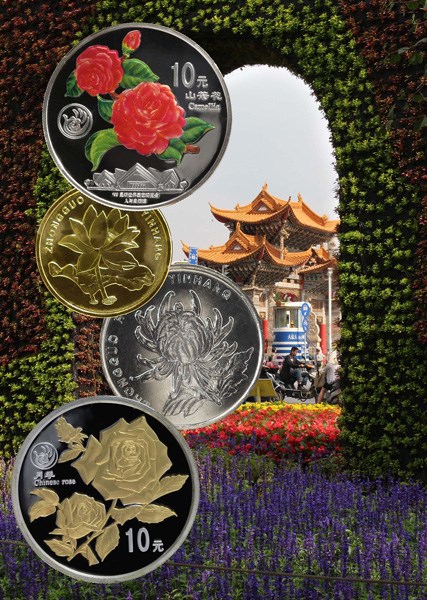Chinese Coins: Flower’s Power
Posted on 5/8/2018
By
Peter Anthony
“What happens to Spring flowers in Shenyang,” my friend says, “is that after a couple of days, the wind starts to blow and all the petals soon cover the ground.”
We stroll past a row of white-blossomed cherry trees that border the Shenyang Mint’s main street. The Mint compound is sealed off from the outside world by high walls and is patrolled by the People’s Liberation Army. It’s usually pretty quiet. Today, the calm is broken by a familiar thud-thud-thud as a soldier yo-yos a basketball up and down the Mint’s outdoor court. The players pause for a moment, surprised to see a visitor.
At opening and closing times, this avenue bustles with pedestrians. Lunch hour, too, is busy as the staff rushes to the mint cafeteria (darn good, by the way) and then back to their posts. You can meet anyone there; from production line workers to the Mint’s leaders. Most people dress in mint garb embroidered with the red logo of China Banknote Printing & Minting. CBPM is the parent organization for all the mints except Guobao in Shenzhen.
The flowers ignore the still-cold air temperature and shimmer in Liaoning Province’s sunshine. Spring is here. Near the entrance to the main office building another tree is covered with white blooms: Magnolia Yulania. I can say that confidently because there is a little plaque on the tree’s trunk that identifies it. It’s easy to be a botanical know-it-all in China. Many of the trees and shrubs in parks and government facilities have tags attached to them. These denote their scientific name in both Latin and Chinese.
Flowers have symbolic meanings in Chinese culture and coins represent these qualities. The simple beauty of Chrysanthemum flowers conveys the virtues of humility and longevity. This flower appears on the circulating copper-nickel one Yuan coin and the fractional one Jaio. The lotus, a symbol of nobility and purity, adorns the brass five Jiao coin.
Floral themes also bloom among precious metal coins, and Shenyang plays a role in that. In 2006, the city hosted an International Horticultural Expo. For this event, acres and acres of flowers were planted, including five and a half million tulips. China Gold Coin Inc. (the China Mint) struck 10,000 ¼ oz. 100 Yuan gold Panda coins and 30,000 1 oz. 10 Yuan silver Panda coins with the words, “In Commemoration of International Horticultural Exposition 2006 Shenyang • China.”
 |
| Among China's money with floral designs are the common 1 Yuan and 5 Jiao circulating coins and the pair of 1999 10 Yuan silver World Horticultural Exposition commemoratives. In the background is Kunming, The City of Eternal Spring. It was host city for the Expo. |
The second time a Panda coin was minted for a horticultural exposition was eight years later in 2014. This time the show took place in the lovely seaside city of Qingdao in Shandong Province. The mintage was 8,000 gold ¼ oz. 100 Yuan gold Panda coins and 40,000 1 oz. 10 Yuan silver Panda coins with the words, “In Commemoration of International Horticultural Exposition 2014 Qingdao.”
Perhaps the most direct tribute to China’s floral heritage is a pair of 10 Yuan silver coins released for an earlier expo. The 1999 World Horticultural Exposition took place in the hills overlooking Kunming, the capital city of Yunnan Province. This was the first large-scale international fair that China had hosted in modern times. The theme was “Man and Nature, Marching into the 21st Century.” 9.5 million people from around the world attended.
Today, the Kunming Expo grounds are still beautiful, but much less crowded. Retired people and parents with children walk the paths and sit on benches. The houses that held the international exhibits are still maintained. There are vast beds of flowers to enjoy. Kunming, after all, is known as “The City of Eternal Spring.” The pair of colored 1999 silver coins from the Expo remain interesting, too. A rose appears on a mint state coin, while a Camelia is featured on a proof. Mintage for both is 100,000 and they almost always are sold together as a pair.
The pair are not evenly matched, though, when it comes to grading. The NGC Census shows that 76% of the rose coins are MS 69, but only 26% of proof Camelias achieve PF 69 quality. There are no perfect 70s of either. An hour spent sorting through these coins in Beijing‘s Madian Coin Market reveals the reason for the disparity. The Camilias are simply hard to find without white spots. This is a big mintage coin that is elusive in problem-free condition.
It’s hard to worry about grades, though, when the sun is shining, the birds are singing and gardens are blooming all over China. Sure enough, however, a wind hard enough that you could barely walk into it blows through Northern China a few days later. But, not everything is lost; there are more flowers to come this Spring and something special to look forward to; in April of 2019, a spectacular new horticulture expo will open in Beijing. Will some new floral-themed Chinese coins be issued for it? Patience is a virtue, or, “Young plants cannot be forced to grow by stretching them."
Peter Anthony is an expert on Chinese modern coins with a particular focus on Panda coins. He is an analyst for the NGC Chinese Modern Coin Price Guide as well as a consultant on Chinese modern coins.
Stay Informed
Want news like this delivered to your inbox once a month? Subscribe to the free NGC eNewsletter today!
